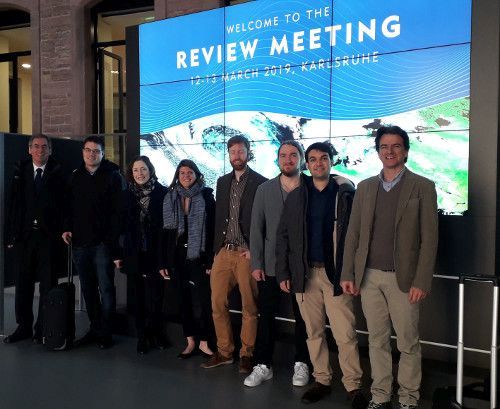DFG Collaborative Research Center “Waves to Weather” enters 2nd phase
Guests from Mainz and Munich in the entrance hall of KIT’s Presidium building during the international review meeting in March 2019
Our ability to predict the weather up to a week or more ahead saves our societies billions of Euros annually and protects human life and property. Increasing computing power and new observations have led to continuous improvements in forecast quality over many years, but still forecasts are sometimes strikingly poor. This is not just due to defects in our forecasting methods – in a chaotic atmosphere, some weather situations are intrinsically hard to predict. The great challenge today is to identify the limits of predictability in different situations and produce the best forecasts that are physically possible. This challenge is taken up by the Transregional Collaborative Research Center "Waves to Weather" (CRC 165, W2W; http://www.wavestoweather.de), which is funded by the German Research Foundation (DFG) since 2015 and has now received renewed funding for the next four years (2019–2023).
In Phase 1, fundamental discoveries were made regarding the mechanisms of error growth, and new methods were developed to measure the uncertainty resulting from incomplete knowledge of cloud processes. Innovative statistical and visualization tools were implemented to learn about uncertainty in ensemble prediction systems.
In Phase 2 researchers will attempt to identify the weather events where intrinsic limitations on predictability have greatest impact on forecast skill, and how we can best make probabilistic forecasts in situations where the overall predictability is low. New methods will be developed to combine statistical and dynamical information. A new research focus has been added to consider regime transitions at forecast lead times of up to a month.
"This collaborative project is unique in Germany, and perhaps in the world, because it brings fundamental research in atmospheric science together with state-of-the-art methods in visualization, statistics and machine learning and applies them to real-world weather forecasting problems" explains Professor Peter Knippertz from the Institute of Meteorology and Climate Research (IMK). Prof. Knippertz adds that “W2W has become a key research activity for the institute with seven principle investigators and eleven PhD students/postdocs. In Phase 2, we will further intensify collaboration with mathematicians in the framework of the recently founded center MathSEE (http://www.mathsee.kit.edu). Researchers in Karlsruhe will concentrate specifically at the forecast of extreme and high-impact weather events such as heat waves, hail and windstorms, tropical cyclones and heavy precipitation.“ In addition to KIT, the consortium includes the Ludwig Maximilian University Munich (coordinating university), Johannes Gutenberg University (JGU) in Mainz, the Heidelberg University (RKU), the Technical University Munich (TUM), the German National Aeronautics and Space Research Center (DLR), and the Hamburg University (UHH).
Working groups:
Atmospheric Dynamics
Cloud Physics
Regional Climate and Weather Hazards
Atmospheric Risks
Junior research group: Clouds and storm tracks
Junior Investigator Group: Large-scale Dynamics and Predictability

